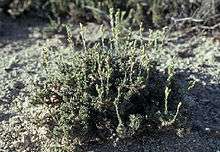Artemisia pygmaea
Artemisia pygmaea is a North American species of sagebrush in the aster family known by the common name pygmy sagebrush.[2]
| Artemisia pygmaea | |
|---|---|
 | |
| Scientific classification | |
| Kingdom: | Plantae |
| Clade: | Tracheophytes |
| Clade: | Angiosperms |
| Clade: | Eudicots |
| Clade: | Asterids |
| Order: | Asterales |
| Family: | Asteraceae |
| Genus: | Artemisia |
| Species: | A. pygmaea |
| Binomial name | |
| Artemisia pygmaea | |
| Synonyms[1] | |
| |
Distribution
Artemisia pygmaea is native to regions of the Southwestern United States, encompassing parts of Nevada, Utah, Colorado, Arizona, and New Mexico.[3] It is uncommon throughout much of its range but it can be locally abundant.[4][2]
Artemisia pygmaea grows in very dry habitat types. It occurs in the desert grasslands, pinyon-juniper woodlands, and playas of the American southwest, especially in the Great Basin and Uinta Basin. It favors calcareous soils such as gypsum, and alkali soils, salty soils, and clay. It tolerates substrates in which few other plants will grow. Its small size is an adaptation to its dry habitat.[4][5]
Description
Artemisia pygmaea is a small, cushion-like shrub growing up to about 20 centimeters (8 inches) in height. It is woody and grows from a taproot.[2]
The small leaves are under a centimeter long and wide and are toothed or divided into several deep lobes.[2]
The flower heads contain 3 to 5 disc florets but no ray florets. It is dioecious, with male and female flowers occurring on separate individual plants.[4] Blooming occurs in August and September.[6][2]
This is one of several plants parasitized by the parasitic plant Orobanche fasciculata.[7]
References
- The Plant List Artemisia pygmaea A.Gray
- Flora of North America, Pygmy sage, Artemisia pygmaea A. Gray
- Biota of North America Program 2014 county distribution map
- Ulev, Elena D. 2005. Artemisia pygmaea. In: Fire Effects Information System, [Online]. U.S. Department of Agriculture, Forest Service, Rocky Mountain Research Station, Fire Sciences Laboratory.
- Gray, Asa. 1886. Proceedings of the American Academy of Arts and Sciences 21(2): 413
- Artemisia pygmaea. USDA FS International Institute of Tropical Forestry.
- Brotherson, J. D., et al. (2005). Nutrient relationships between Orobanche fasciculata Nutt. and its host Artemisia pygmaea Gray in the Uinta Basin of Utah.Western North American Naturalist 65(2) 242-47.
External links
| Wikimedia Commons has media related to Artemisia pygmaea. |
- The Nature Conservancy: Artemisia pygmaea
- Artemisia pygmaea in the CalPhotos Photo Database, University of California, Berkeley
